Tata Motors is stepping back into the very arena it built, and the competition that's waiting inside has moved the game far ahead from the standard set by the old Indigo CS. We’re talking about compact sedans, of course, and what Tata started, Maruti popularised, and then Honda and Hyundai refined some more.
So where does the Zest fit into all of this, and can it possibly live up to Tata’s rather ambitious claims about its abilities? Let’s compare the things that matter.
The outside
‘Different strokes for different folks’ goes the old adage, and we’ve heard our fair share of arguments about which of the compact sedans looks best, so we’ll leave that up to you. What is pretty clear is that the Amaze and Xcent have a more conventional, three-box sedan profile, while the Dzire and Zest – whose hatchback origins were quite large – have stubbier, less proportionate boots. Still, we’d say Tata has done a better job of tacking the boot on than Maruti has.

The minor sculpting to the nose, flourishes of chrome and LED daytime-running lamps have suitably transformed the old Vista into a face that is all new. The creases that run along the doors and the large, wraparound tail-lamps are neat touches too. The Dzire’s long nose, short bonnet design looks a bit ungainly, but at least its chunky alloy wheels give it a planted stance. The Xcent and Amaze too have a good amount of chrome detailing to liven up their exteriors, but the narrow Hyundai looks half a size down on the others. The Zest, Dzire and Xcent ride on 15-inch wheels, while the Amaze sticks to 14-inchers. To our eyes, the Amaze pulls off the look best, with the Xcent not too far behind, but we’ll let you decide for yourself.
The inside
In terms of cabin design, we think Tata has done a fine job with the Zest. It doesn’t just look more attractive than any previous Tata, it looks attractive, full stop. The steering wheel and dials in particular look very smart, and the audio system is smartly integrated in the central console. The Xcent and Dzire score highly here too; both look smart and are logically laid out, the Hyundai looking especially upmarket. This is where the Amaze falls short though, its dashboard looking bare and the instrument panel appearing low cost.

When you look at material quality and fit and finish, the Xcent comes out on top with a cabin ambience that feels like it belongs to a car in a higher class. The Dzire too feels quite well made from the inside with some chunky switchgear, a smart looking central console and plush fabrics. The Zest holds up well in this company and you’d really be hard pressed to tell you were inside a Tata car. If there is a fault it’s that there isn’t enough storage space; the door pockets are too slim and there’s just a single, shallow cupholder. The Amaze’s cabin doesn’t match the ambience of the others but it’s hard to fault the fit and finish except for the glovebox which doesn’t shut flush.
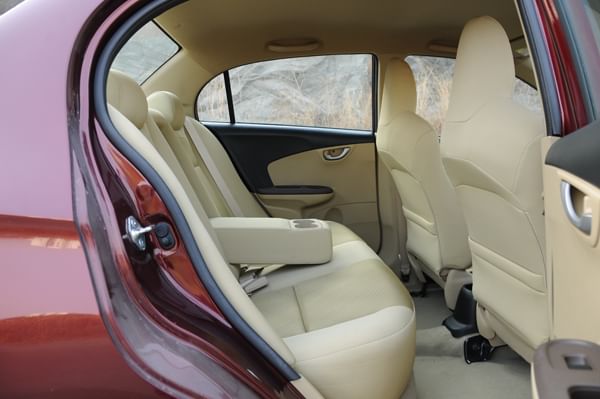
The Amaze and Xcent both have rather heavily contoured seats that have been scooped out to maximise space, but the seats in the Amaze are just a bit softer and more comfortable. The Amaze is also a lot wider than the Xcent, and actually on par with the Zest. In fact, the overall sensation of space is the best in the little Honda and you do actually get great legroom and headroom in the back seat. The Xcent and Zest offer up good legroom and headroom as well, but the Dzire fares quite poorly in this regard; it’s about the same as your average premium hatchback.

The features
It’s hard not to be impressed with how much Tata has packed into the Zest, particularly its new Harman-sourced touchscreen infotainment system on the top XT trim. The unit looks and feels very upmarket and has a lot of functionality built into it. There’s a visual aid for the parking sensors, you can control the climate control, album covers of audio tracks display in full colour, it will read your texts out to you, and it accepts voice commands too. The audio system is missing a CD player, but it does get aux, USB and an SD card reader, and the eight-speaker setup sounds fantastic. However, the screen is hard to read in daylight and the voice commands don’t work flawlessly. LED daytime-running lights and follow-me-home projector headlamps, which none of the others have, are part of the equipment package on the top-end models

The top Xcent SX (O) may not have a touchscreen, but it does offer more by way of 1GB of onboard storage, a rear-view camera, a cooled glovebox, keyless entry and go, and even rear air-con vents (the only car here with them). It also gets a leather-wrapped steering wheel, auto climate control, Bluetooth, USB, aux and a CD player. Despite the Zest’s techie touchscreen, for all practical purposes, the Hyundai is the best equipped car in this comparison.
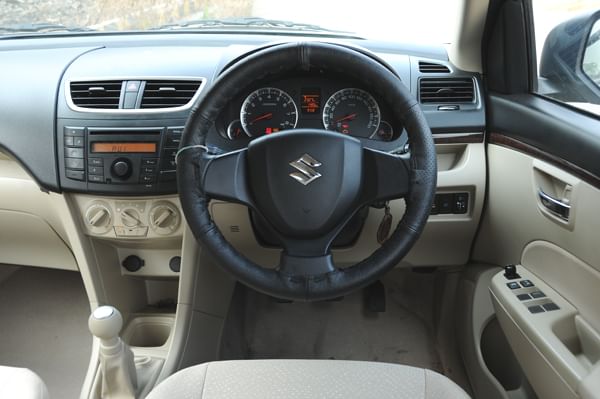
The Dzire ZXi isn’t too far behind, getting all the basics, apart from Bluetooth and parking sensors. The Amaze, however, takes a huge hit here. There’s no CD player, no Bluetooth, no climate control and no parking sensors either. It’s good to see that all these top trims have been given adequate safety kit in the form of two airbags and ABS with EBD.
The powertrain
We won’t be comparing the diesels this time around because the only Zest diesel Tata’s let us sample so far is an automatic, and the competition just doesn’t have a direct answer to that yet. So it’s the petrols that are facing off, and on paper, Tata’s new 1.2 Revotron turbocharged motor seems to have the advantage. Its 89bhp (5bhp higher than the Auto Expo show car, incidentally) is class leading, but only just. The Amaze has 87bhp, the Dzire 86bhp and the Xcent 82bhp. The real advantage of a turbo engine is its torque, which at 14.27kgm from just 1,750rpm bowls away the other three and their naturally aspirated engines, which produce between 11.1 and 11.6kgm, and all beyond 4,000rpm. Also, it may be turbocharged, but the Revotron 1.2T is an old-school engine. While the Maruti, Honda and Hyundai use aluminium blocks, variable valve timing and four-valve heads, the Tata soldiers on with a cast-iron block and two valves per cylinder. But how does all this translate on the road?

For a turbo engine, the Zest is surprisingly driveable, getting off the line smoothly and transitioning seamlessly when the boost comes in. There’s no big surge in the mid-range as you might imagine, but power is delivered in an effortless manner. It doesn’t like to be revved though, and isn’t as rev happy as the others– the Honda i-VTEC in particular. At low revs, below around 1,700rpm, the engine does feel a bit sluggish but if you amble along at part throttle, you won’t miss the punch. It’s quite the opposite with the Xcent’s Kappa2 petrol engine, which has a lot of pep off the line. In fact, it’s so responsive that it can be a little jerky when you’re pootling around in traffic. Its mid-range and top-end performance are adequate for a car of this size and weight though.
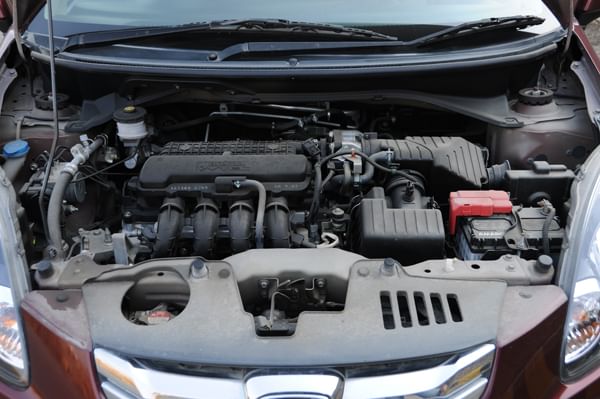
The rev-happy Amaze is at its best past 4,000rpm, and your inner petrolhead will love to visit the redline every chance you get. Trouble is, in traffic, it takes some time to get going from low revs, and you will find yourself shuffling through the gears often. The Dzire’s K12 engine is the best compromise of the naturally aspirated motors, having enough pep at low speeds with an ample mid-range and top end too. The K12 is an incredibly smooth and sweet engine which doesn’t feel strained even when you rev it hard.
The chassis
The work Tata’s engineers have done on the Zest’s chassis and suspension really is something exceptional. The way it glides over bad roads completely unruffled puts it in a different league. And it does it silently too, with very little road and wind noise making it to the cabin. The long wheelbase, ‘dual path’ dampers and a completely re-worked wheel geometry have paid off handsomely. Around corners, the tall and heavy Zest does roll a fair bit but not excessively to take the fun out of driving hard on a twisty road. The new electric power steering is also really good and apart from a little lightness at the straight-ahead position at higher speeds, it gives you a good amount of feedback.
Our previous ride and handling champ in this segment was the Swift Dzire, and though it comes close, it’s finally been beaten; the Zest’s setup is just that good. The Maruti still has an excellent blend of comfort and agility, and it’s really a hoot to drive. Maruti engineers are masters of suspension tuning on Indian roads and the Dzire is proof of their skills.
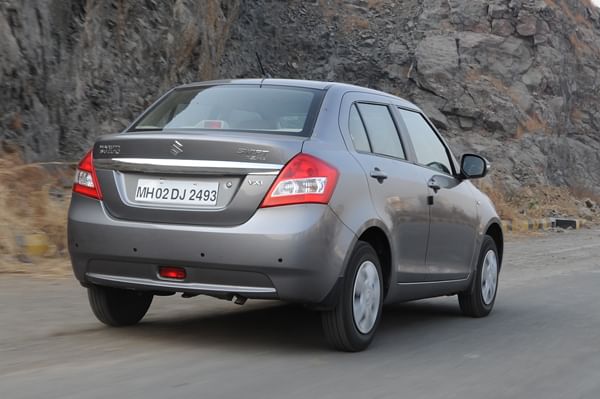
The Amaze is also a whole lot of fun to drive, with a steering that’s light but still has quite a lot of feel. The suspension offers up fantastic stability and great body control, and though it’s clunkier and a bit harsher than the others, it’s not at all uncomfortable. What lets it down is the refinement. Thanks to poor cabin insulation, you constantly hear and feel every single bump and expansion joint, and this is really something Honda needs to work on.

The Xcent’s setup works well in the city – fine if you’re not in a hurry. The rather emotionless steering is light and easy, and the suspension, though better than a lot of previous Hyundais, is still clunky and inconsistent. Although it’s quite composed around corners, potholes and the like will definitely be felt in the cabin. The Xcent is also very susceptible to crosswinds at high speeds.
Pick and choose
As we said at the start of this comparison, the Honda, Hyundai and Maruti are so closely matched that picking between them can be down to your preferences. The Xcent scores highly if you use it mainly in the city and if you value lots of features and a quality cabin which is surprisingly spacious for a car of this size. The generous boot rounds off what feels like a very complete car
If you’re an enthusiast who wants a rev-happy, fun-to-drive sedan that looks good and has a lot of space, the Amaze is a good pick if you don’t mind a bit of road noise filtering in and a spartan cabin.
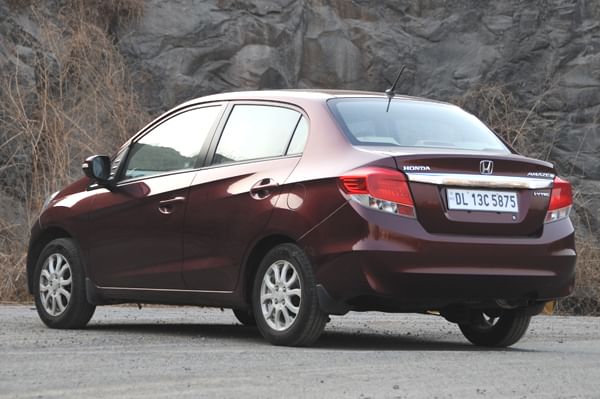
We couldn’t possibly discourage you from choosing the peace of mind that comes by default with the Dzire, especially since you also get great ride and handling and a peppy engine along with it. The cabin is the least airy but the plush seats make up for the lack of space. Yes, it’s the oldest among present company and due for a facelift but the Dzire is one car that you can’t go wrong with.

That’s not something you could say for a Tata car whose reputation for reliability and durability is always suspect. The company hopes to change that perception with the Zest’s solid build and well-appointed cabin. There’s no doubt the Zest is a very accomplished car. It has the best ride, it handles well, it’s pretty well equipped, it’s very spacious and comfortable, and knowing Tata, it’s bound to be well priced too. You will have to look past a few fit and finish issues and a boot that’s not too large. The engines too are nothing exceptional but as a package, it’s a car we have no hesitation to recommend. With the Zest, Tata is back in the fight.
| Tata Zest 1.2 Revotron XT | Hyundai Xcent 1.2 VTVT SX (O) | Honda Amaze 1.2 i-VTEC VX | Maruti Swift Dzire 1.2 VTT ZXi |
Price (ex-shr, Delhi) | Rs 6.2 lakh (est) | Rs 6.25 lakh | Rs 6.58 lakh | Rs 6.31 lakh |
(L/W/H) | 3995/1706/1570mm | 3995/1660/1520mm | 3990/1680/1505mm | 3995/1695/1555mm |
Wheelbase | 2470mm | 2425mm | 2405mm | 2430mm |
Kerb weight | 1135kg | NA | 975kg | 990kg |
Engine | 4 cyls, 1193cc, | 4 cyls, 1197cc, petrol | 4 cyls, 1198cc, petrol | 4 cyls, 1197cc, petrol |
Gearbox | 5-speed manual | 5-speed manual | 5-speed manual | 5-speed manual |
Power | 88.7bhp at 5000rpm | 81.8bhp at 6000rpm | 86.8bhp at 6000rpm | 86bhp at 6000rpm |
| Torque | 14.27kgm at 1750-3500rpm | 11.6kgm at 4000rpm | 11.11kgm at 4500rpm | 11.6kgm at 4000rpm |
Ground clearance | 175mm | NA | 165mm | 170mm |
Boot volume | 360 litres | 407 litres | 400 litres | 316 litres |
Tyre size | 185/60 R15 | 175/60 R15 | 175/65 R14 | 185/65 R15 |






Comments
Member Login
Personal Details
No comments yet. Be the first to comment.